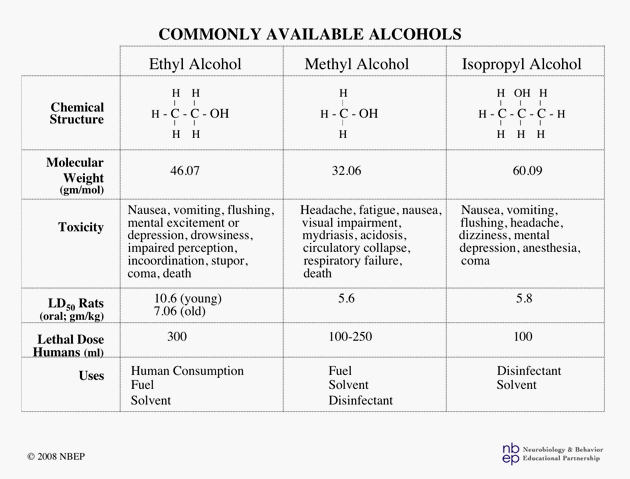Ethyl alcohol is the only commonly available alcohol that is ingested for its behavioral effects. Isopropyl alcohol (rubbing alcohol) produces unwanted effects and methyl alcohol is toxic. On some occasions when ethyl alcohol is not available, individuals will ingest isopropyl alcohol or methyl alcohol as a substitute, with serious adverse consequences.
-
common alcohols

-
Ethyl alcohol is metabolized to acetaldehyde by alcohol dehydrogenase. Alcohol dehydrogenase is present in gastric fluid where it is about 60% more active in men than in women. This increased activity in addition to the decreased size and higher fat to water ratio in women can help account for the increased blood alcohol levels in women following 1 drink compared to men. The majority of acetaldehyde is metabolized to acetic acid in the liver by acetaldehyde dehydrogenase and by reducing its catalytic activity prior to drinking alcohol results in higher levels of acetaldehyde. Accumulation of acetaldehyde produces adverse symptoms including flushing, nausea, headache, and increased heart rate.
ethanol metabolism
-
Methyl alcohol is metabolized by alcohol dehydrogenase to formaldehyde, which is toxic. In methyl alcohol poisoning, ethyl alcohol administration competes with methyl alcohol metabolism and can reduce toxicity.
Methyl Alcohol
-
Isopropyl alcohol is the toxic agent in isopropyl alcohol poisoning and since ethyl alcohol competes for its degradation by alcohol dehydrogenase, the administration of ethyl alcohol is contraindicated in its treatment.
Isopropyl Alcohol
CURRENT LESSON OBJECTIVES
- What constitutes 1 drink?
- How do the number of drinks affect blood alcohol levels and behavior?
- What is the difference in blood alcohol per drink in men and women?
- What are the factors that alter the relationship between drinks ingested and BAL?
- Describe the metabolism of ethyl, methyl and isopropyl alcohol.
- What is the most important genetic factor that alters alcohol metabolism and dependence?
- How does acute tolerance change the behavioral effects of ascending and descending BAL?
- How does subjective elation and intoxication relate to rising and falling BAL?
- How does alcohol induced stimulation and sedation relate to binge drinking?
- What are the motor and cognitive impairments along the ascending and falling BAL curve?
- What are the persistent effects of alcohol after BAL reaches 0?
- Describe chronic tolerance to alcohol effects.
- Summary
RELATED RESOURCES
Related Clinical Cases
- Adolescent Drinking (Sneaky Teen is Not Squeeky Clean)
- Alcohol Withdrawal focuses on
- Binge Drinking in College (Rebel Without a Cause)
- Fetal Alcohol Syndrome (FAS) focuses on
Related Quizzes
- Alcohol and accidents focuses on
- Alcohol and adolescence focuses on
- Alcohol Genetics focuses on
- Alcohol withdrawal focuses on
- Diagnosis and treatment focuses on
- Epidemiology
- Fetal alcohol syndrome focuses on
- Medical complications
- Neurobiology focuses on
- Pharmacology and acute effects alcohol
- Regular drinking focuses on
